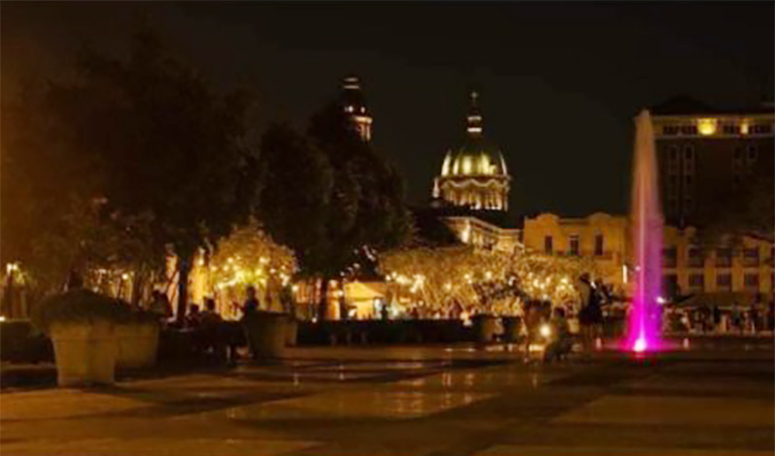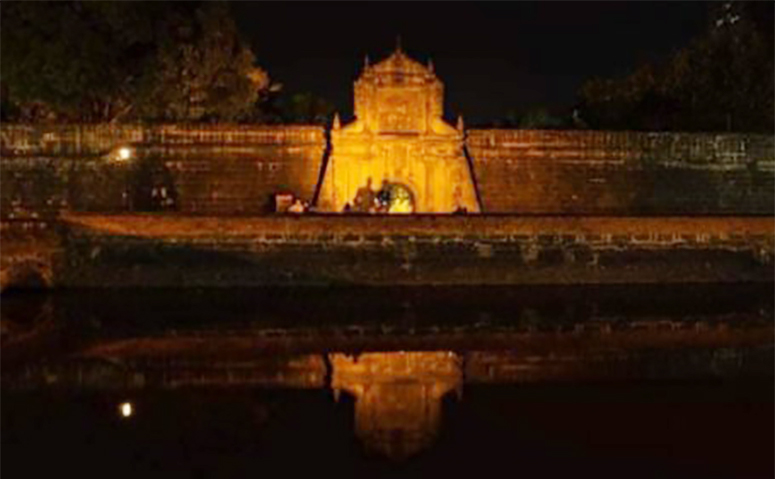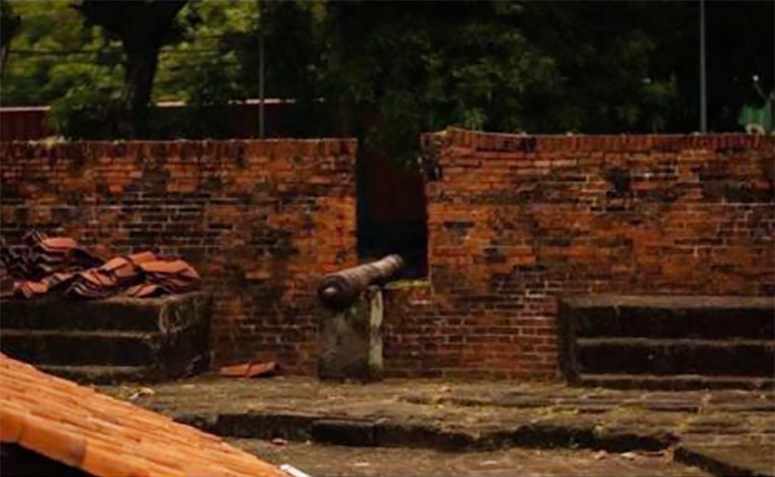You don’t need to search for lost souls because the stray spirits will come to you,” tipped a seasoned senior student to a guileless freshie, both students of the forested University of the Philippines in Los Baños (UPLB or “Elbi” for short).
The Baths
The first time I went there as a boy scout, I thought it was a resort. After all, “Los Baños” means “The Baths”. The neighboring towns are dotted with private pools that are actually hot springs inside private properties. What makes this place more enchanting is the legend of Maria Makiling, a goddess in pre-colonial Philippines who was often invoked to stop flooding, storms, and earthquakes.
Boy Scout
In the early ’70s, I was one of the few scouts chosen to represent my school in an international jamboree in Mount Makiling. It was my first time to be away from my family during Christmas.
One night, I walked alone in the forest for no apparent reason. While deep in the dark woods, I got scared out of my wits when I saw small white lights that seemed to go towards me. I scampered back to our campsite and was surprised to see a familiar-looking man from afar. It was my uncle! He was doing the rounds as a PLDT supervisor. I told him what I saw and he gave out a big laugh. I thought they were orbs, but he said they were fireflies!
Mountaineer
After college, my love for the outdoors morphed into mountaineering. If Makiling was the peak achievement for a scout, this majestic mountain is considered a minor climb as far as elevation is concerned, from a mountaineer’s viewpoint. But don’t underestimate Makiling for it has claimed quite a few lives including a friend of our club. The funny episode with the fireflies has been forgotten. This time, there are no more small white lights but small, white, slimy creatures–leeches! Worse, it’s the smaller variety called “limatik” or blood leeches. I don’t care if leeches improve blood circulation or prevent blood clots. As far as I am concerned, they’re mini vampires or blood suckers that can even enter your private parts and other orifices on your body. A diving instructor friend of mine said she’d rather face sharks than leeches.
Campsite stories
Upon reaching the peak, we set up camp, cooked dinner, and gathered around for the evening socials. Now, “campfire stories” are usually borderline risque but this time it was different. One of the climbers was from “Elbi” and he had many stories, some of them personal. One of them was about an encounter with a human-shaped phantom standing near the old hanging bridge at around 11:00 p.m. It had no feet and just floated without a shadow even though it was near a lamp post. Another story was about a heavy bipedal creature jumping on the roof. The ghosts even have names–Blue boy, Sunog, the Red and Black Ladies of Agronomy, and the Lady of Pili Drive. Many places were said to be haunted such as the Math building and the Main Library, but the scariest among them was the Men’s Dorm.
Ghost tours
When I became a heritage tour organizer, I became interested in ghost tours not as an organizer but as a participant. Way past my scouting and mountaineering days, I went back to UPLB as a tourist. We went to the usual tourist areas such as the National Arts Center and a forested area that I thoroughly enjoyed. It felt like an excursion more than a ghost tour. Until we came to the last part.
The last destination was Baker Hall. This structure, built from 1927 to 1938, is one of the oldest in the area and was part of the Los Baños Internment Camp in WWII. It was declared a historic site by the National Historical Commission of the Philippines in 2005 during the 60th commemoration of the Raid on Los Baños in 1945. That raid was one of the most successful rescue operations in modern military history, which liberated 2,147 internees and killed 250 Japanese soldiers. It was also a place of torture.
We were all tired and hungry when we arrived at Baker Hall. We were not as cohesive as we were at the start of the tour so some went out in small groups. I went inside alone and saw a group of students rehearsing a play.
We regrouped after in the the grassy field across the building and things started to get scary. Apparently, two lady participants who had their third eyes open felt something heavy and eerie. I didn’t think they were possessed but were probably on the verge of it. I never got to talk to them. Later, I learned that some students saw the ghosts of Japanese soldiers marching around the hall.
We formed a big circle and the organizers started to perform some strange rituals. I think it was salt that they were sprinkling around the area. I wanted to get out of the circle but nobody seemed to want to leave early except me. I was getting uneasy with all the abracadabra going on but I had no choice but to stay because I didn’t know how to get home. So I endured the ordeal until it was over.
Diliman
Previous to UPLB, I also attended a ghost tour in U.P. Diliman. It’s not called “Diliman” for nothing. I remember my dad told me that some of his contemporaries opted not to study in U.P. in the ’50s because they found the campus too spooky at night. It still felt spooky whenever I picked up my wife after her night classes. In fact, she refused to go to the Education Building washroom alone because she once saw dirty, greasy feet inside one of the cubicles. There are also stories of roaming spirits of professors long gone. I’ve heard many stories of disappearing jeepney passengers and the ghost of a student-actress haunting Palma Hall. The tour guide also mentioned that U.P. DMST and Carillion have a “presence”.
The most frightening story, however, was told by my friend who, while alone bathing in the common bathroom inside a ladies’ dorm, two droplets of fresh blood fell on her shoulder and on her foot. In her home province, she also experienced shaking beds and orbs following her. She even described orbs as having distinct personalities with a nucleus when seen up close. If you think these spirits appear only in old buildings, you might be in for a surprise as they also appear in relatively new buildings in Diliman.
Ermita and Malate
At the oldest U.P. campus in Manila, a medical student dissecting a cadaver lost her ring only to find it on the finger of the cadaver.
We have to remember that U.P. PGH (Philippine General Hospital) is at the heart of the Ermita and Malate districts, which were almost totally destroyed, together with Intramuros, Pasay, Binondo, and Sta. Cruz, during the Battle for Manila. An estimated 100,000 people perished during this month-long carnage.
Intramuros

Intramuros was also devastated, with the San Agustin Church as the only structure that survived. Fort Santiago was not just a military fort but also a prison during the Spanish and Japanese occupation. Many were executed inside the fort. Its most famous prisoner was our national hero himself, Jose Rizal. One of the most popular spots inside the fort is the dungeons wherein you have to duck to see inside the claustrophobic cells.

The ghost tour guides of Intramuros will tell you to stare at a dark dungeon and wait for a woman to look back at you. They will also tell you about the soldier assigned at the Palacio del Gobernador who woke up in Mexico after resting in the Palacio. The watch tower on top of the walls is allegedly visited by the ghost of a lady guard who used to work there. The most haunted place, according to one guide, is the Aduana / Intendencia, which has long been abandoned. He claimed that there is a portal there to the netherworld.

In and out of Manila
There are many other haunted places in and out of Manila. Schools, hospitals, seminaries, churches, abandoned houses are commonly inhabited. U.S.T., the country’s oldest school, was a WWII internment camp. La Salle was the site of an infamous massacre. A headless Jesuit appears in a 24-hour Ateneo seminary library. So does a murdered Math professor at San Beda. Probably the scariest place to encounter a ghost is the comfort room. Maybe that’s why one comfort room at St. Scholastica has no mirror!
It’s important to know the history of a place. Starmall Alabang, Harrison Plaza, Remedios Circle, and Espiritu Santo parish were former cemeteries. Lyceum used to be San Juan de Dios Hospital. Former American bases have their own share of horror stories. Subic has the ruins of the U.S. Navy Hospital, while Clark has the abandoned Clark Air Base Hospital, which was featured in National Geographic. Another military institution is Corregidor Island, especially Malinta Tunnel wherein a few inches of blood flooded it during WWII.
Even new structures and swanky villages are not exempt. If Baguio has Laperal House, Teachers’ Camp, and Diplomat Hotel, Quezon City has the old houses of New Manila and Balete Drive.
Whether you’re a heritage advocate, amateur ghost hunter, or plain exercise buff, these adventure walks are worthwhile activities to get you out of your pandemic rut. While soul searching, remember to just have fun and not get too engulfed in esoterica and mysticism by keeping a strong faith in God.
JP Ordoña (Manilakad) leads Manilakad Walks in Intramuros, Binondo, Quiapo, and more. In between, he writes, climbs, dives, and more. Let him guide you to several walking destinations in Manila. Manilakad (JP Ordoña) can be reached on Facebook Messenger or through text at 0916-3597888.
